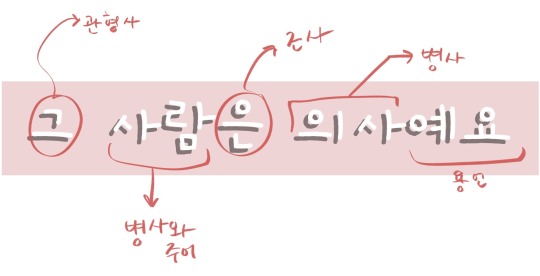#mans put a singular ㅋ
Photo



my dads are hip
#namjoon#jin#btsgif#dailybts#dailybangtan#btsedit#rm#seokjin#namjin#natgifs#natposts#tHEY'RE SO FUNNY#the way they bob their bodies is hilarious to me#also jin is being sarcastic on weverse and its so funny#mans put a singular ㅋ
183 notes
·
View notes
Photo

품사 - Parts of Speech
Since my post from yesterday, I got a lot of requests to do more linguistic terms. I don’t think this is a comprehensive list, so if there’s any that you know that aren’t here, put it in the chat! Enjoy <3
♡ 자음 – consonant
ex. ㄱ, ㄷ, ㄴ, ㅅ, ㅇ
♡ 모음 – vowel
ex. 아, 어, 이, 애
Hangul [ x || x ]
♡ 초성 – word-initial consonant
ex. ㅂ in 볶음
♡ 중성 – word-medial consonant
ex. ㄲ/ㅇ in 볶음
♡ 종성/ 받침 - word-final consonant (받침 literally means “support”)
ex. ㅁ in 볶음
♡ 글자 – letter
♡ 발음(하다) – pronunciation (to pronounce)
ex. 볶음 -> 보끔
♡ 예사소리/평음 – plain consonant (lit. ordinary sound/peaceful note)
ex. ㄱ, ㅂ, ㄷ, ㅅ, ㅈ
♡ 된소리/경음 – tense consonant (lit. Fortis sound/hard note)
ex. ㄲ, ㅃ, ㄸ, ㅆ, ㅉ
♡ 거센소리/격음 – aspirated consonant (lit. rough sound); 거센 from 거세다 (to be rough/violent)
ex. ㅋ, ㅍ, ㅌ, ㅊ
✿ 한국어를 배우는 외국인들은 된소리와 거센소리의 발음을 어려워한다. Foreigners learning Korean have a difficult time pronouncing tense and aspirated sounds.✿
♡ 복합어 – compound
ex. 물고기 (물 “water” + 고리 “meat”), 남자친구 (남자 “boy/man” + 친구 “friend”)
♡ 파생어 – derivative
ex. -관 (building – from 館); 영화 “movie” + -관 = 영화관 “theatre (lit. movie building)”
♡ 접두사 – prefix
ex. 되- (similar to “re-” prefix in English); 되- + 들다 “to enter” = 되들다 “to reenter”
♡ 접미사 – suffix
ex. -님 (polite title for someone older/you don’t know); 기사 “driver” + -님 = polite form to address the driver
♡ 어간 – stem
ex. 먹 from 먹다
♡ 어미 – ending
ex. -고 있다 (progressive tense); 먹다 + -고 있다 = 먹고 있다 “to be eating”
♡ 속어 – slang expression
♡ 숙어 – idiomatic expression
♡ 반의어 – antonym
♡ 유의어 – synonym
♡ 어원 – origin / etymology
♡ 예문 – example
♡ 용언 – a conjugated verb
More Parts of Speech - Related to the Sentence
♡ 명사 – noun
ex. 연필 “pencil”, 사람, “person”, 중국 “China”
♡ 대명사 – pronoun
ex. 나 “I/me (informal)”
♡ 수사 – numeral [go here]
♡ 동사 – verb [x || x || x]
자동사 – intransitive verb (cannot take a direct object)
타동사 – transitive verb (must take a direct object)
♡ 형용사 – adjective
ex. 예쁘다 “to be pretty”, 슬프다 “to be sad”
♡ 관형사 – determiner
ex. 이 “this”, 그 “that”, 저 “that over there”
♡ 부사 – adverb
ex. 나중에 “late”, 천천히 “slowly”
♡ 조사 – particle/postposition
ex. 은/는, 이/가, 을/를, 도, 에/에서
♡ 감탄사 – interjection
ex. 우와! “wow”, 아야 “ouch”, 대박 “amazing”, 헐 “omg”, 뭐라고?/뭐? “what?”
♡ 문법 – grammar
♡ 시제 – tense
ex. 과거 (시제) “past”, 현재 (시제) “present”, 미래 (시제) “future”
♡ 인칭 – person
ex. 1(일)인칭 (단수) “first person (singular)”, 3(삼)인칭 (복수) “third person (plural)”
♡ 구(문) – phrase [x || x || x || x]
♡ 절 – clause
♡ 문장 – sentence
♡ 주어 – subject
♡ 서술어 – predicate
♡ 목적어 – object
직접 목적어 – direct object
간접 목적어 – indirect object’
Hope this helped! Happy Learning :)
~ SK101
#korean#korean language#korean language vocab#korean vocabulary#parts of speech#korean parts of speech#learn korean#studying Korean#study korean#learning korean#k vocab#korean blog#korean language blog#kblr#klang blog#klangblr#koreanblr#korean grammar#한국어#한국어 배우기#한국어 공부하기#한국어 문법#한국어 어휘#한국어 블로그#한국#품사#언어학#언어
375 notes
·
View notes